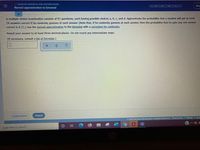
MATLAB: An Introduction with Applications
6th Edition
ISBN: 9781119256830
Author: Amos Gilat
Publisher: John Wiley & Sons Inc
expand_more
expand_more
format_list_bulleted
Concept explainers
Question
thumb_up100%

Transcribed Image Text:O RANDOM VARIABLES AND DISTRIBUTIONS
Sha
Normal approximation to binomial
A multiple-choice examination consists of 95 questions, each having possible choices a, b, c, and d. Approximate the probability that a student will get at most
24 answers correct if he randomly guesses at each answer. (Note that, if he randomly guesses at each answer, then the probability that he gets any one answer
correct is 0.25.) Use the nomal approximation to the binomial with a correction for continuity.
Round your answer to at least three decimal places. Do not round any intermediate steps.
(If necessary, consult a list of formulas.)
Explanation
Check
Terms of Use PrivacyI Acc
O 2021 McGraw-H Education. All Rights Reserved.
Type here to search
Expert Solution
This question has been solved!
Explore an expertly crafted, step-by-step solution for a thorough understanding of key concepts.
This is a popular solution
Trending nowThis is a popular solution!
Step by stepSolved in 2 steps with 2 images

Knowledge Booster
Learn more about
Need a deep-dive on the concept behind this application? Look no further. Learn more about this topic, statistics and related others by exploring similar questions and additional content below.Similar questions
- The proportion of eligible voters who will vote for Shaun Spicer in the next Presidential election is assumed to be 42%. A random sample of 400 voters is drawn and reveals a sample proportion of 40%. Calculate the standard error of the proportion. Round the final answer to four decimal places.arrow_forwardWhen women were finally allowed to become pilots of fighter jets, engineers needed to redesign the ejection seats because they had been originally designed for men only. The ejection seats were designed for men weighing between 150 lb and 201 lb. Weights of women are now normally distributed. with a mean of 169 lb and a standard deviation of 45 lb. Complete parts (a) through (c) below.arrow_forwardIn the “Expected” column, type in a formula that will calculate the numbers you would expect to have if the total number of females and males caught were equal (this will be based on the total number of adult crabs caught).arrow_forward
- For Discrete Matharrow_forwardAssume that when an adult is randomly selected, the probability that they do not require vision correction is 18%. If 7 adults are randomly selected, find the probability that exactly 2 of them do not require a vision correction. if adults are randomly selected the probability that exactly 2 of them do not require a vision correction is _________. (ROUND TO THREE DECIMAL PLACES AS NEEDED)arrow_forwardSuppose that 62% of all college seniors have a job prior to graduation. If a random sample of 100 college seniors is taken, approximate the probability that at most 63 have a job prior to graduation. Use the normal approximation to the binomial with a correction for continuity. Round your answer to at least three decimal places. Do not round any intermediate steps. (If necessary, consult a list of formulas.) 0 X Sarrow_forward
- A recent study has shown that 68% of parents allow their children to ride their bicycles without using a helmet. If we randomly select 25 parents, what is the probability that exactly 18 of the parents allow their children to ride their bicycles without using a helmet? Compute your solution as a decimal and round your final answer to four decimal places. P(exactly 18) = __________arrow_forwardA researcher is interested in the reaction time of college students under high cognitive load. The students are asked to remember a random number sequence. While trying to remember the number sequence, the students are instructed to press the space key after they hear a tone on the computer. The researcher measures the time between when the tone occurs and when the space key is pressed. The variable being measured is a ___________ variable.arrow_forward
arrow_back_ios
arrow_forward_ios
Recommended textbooks for you
 MATLAB: An Introduction with ApplicationsStatisticsISBN:9781119256830Author:Amos GilatPublisher:John Wiley & Sons Inc
MATLAB: An Introduction with ApplicationsStatisticsISBN:9781119256830Author:Amos GilatPublisher:John Wiley & Sons Inc Probability and Statistics for Engineering and th...StatisticsISBN:9781305251809Author:Jay L. DevorePublisher:Cengage Learning
Probability and Statistics for Engineering and th...StatisticsISBN:9781305251809Author:Jay L. DevorePublisher:Cengage Learning Statistics for The Behavioral Sciences (MindTap C...StatisticsISBN:9781305504912Author:Frederick J Gravetter, Larry B. WallnauPublisher:Cengage Learning
Statistics for The Behavioral Sciences (MindTap C...StatisticsISBN:9781305504912Author:Frederick J Gravetter, Larry B. WallnauPublisher:Cengage Learning Elementary Statistics: Picturing the World (7th E...StatisticsISBN:9780134683416Author:Ron Larson, Betsy FarberPublisher:PEARSON
Elementary Statistics: Picturing the World (7th E...StatisticsISBN:9780134683416Author:Ron Larson, Betsy FarberPublisher:PEARSON The Basic Practice of StatisticsStatisticsISBN:9781319042578Author:David S. Moore, William I. Notz, Michael A. FlignerPublisher:W. H. Freeman
The Basic Practice of StatisticsStatisticsISBN:9781319042578Author:David S. Moore, William I. Notz, Michael A. FlignerPublisher:W. H. Freeman Introduction to the Practice of StatisticsStatisticsISBN:9781319013387Author:David S. Moore, George P. McCabe, Bruce A. CraigPublisher:W. H. Freeman
Introduction to the Practice of StatisticsStatisticsISBN:9781319013387Author:David S. Moore, George P. McCabe, Bruce A. CraigPublisher:W. H. Freeman

MATLAB: An Introduction with Applications
Statistics
ISBN:9781119256830
Author:Amos Gilat
Publisher:John Wiley & Sons Inc

Probability and Statistics for Engineering and th...
Statistics
ISBN:9781305251809
Author:Jay L. Devore
Publisher:Cengage Learning

Statistics for The Behavioral Sciences (MindTap C...
Statistics
ISBN:9781305504912
Author:Frederick J Gravetter, Larry B. Wallnau
Publisher:Cengage Learning

Elementary Statistics: Picturing the World (7th E...
Statistics
ISBN:9780134683416
Author:Ron Larson, Betsy Farber
Publisher:PEARSON

The Basic Practice of Statistics
Statistics
ISBN:9781319042578
Author:David S. Moore, William I. Notz, Michael A. Fligner
Publisher:W. H. Freeman

Introduction to the Practice of Statistics
Statistics
ISBN:9781319013387
Author:David S. Moore, George P. McCabe, Bruce A. Craig
Publisher:W. H. Freeman